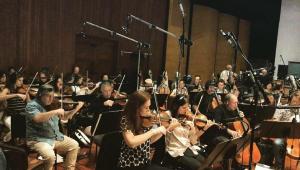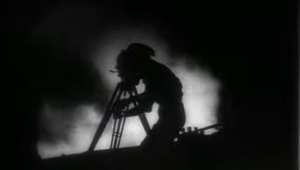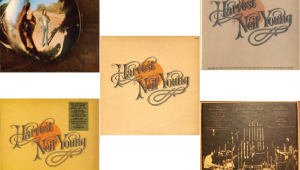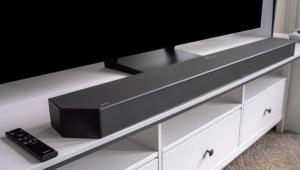I’m always surprised by how much, yet so little changes over time. It feels like we are constantly repeating patterns from the past, just with new technologies. Our team at
Gutter Cleaning Sunderland recently got a new sound system for the office, and it brought back a wave of nostalgia. For the days when I would listen to the Hi-fis in record stores. Feels like I am rekindling my childhood. Thanks Sound & Vision!
Star Date: 1997 - Lessons from the Past Still Apply

In any case, we were visited that year by Phil Abbate, then a reporter for the AAS (Atlanta Audio Society, today the Atlanta Audio Club). Phil interviewed me during his visit to Santa Fe, New Mexico, then the headquarters of Stereophile. Whether that interview ever made it into the pages of the AAS (or onto the bits of the then also nascent internet) I don't know. But during a recent effort to sort out my increasingly cluttered files, I ran across a copy of that interview, which Phil had sent me shortly after it happened. What follows here is a summation of the first part of the interview, significantly shortened and edited for (hopefully) better written English. My verbal responses at the time tended to ramble on with little attention to the organized sentence structure I try (sometimes successfully) to put down in print.
Here I've also minimized or deleted text that applied primarily to Stereophile in 1997, some of it of limited interest to Sound & Vision readers and/or now clearly dated. My reference system, for example, is very different from what it was in 1997. In other respects I've also added to, or altered, text that I feel was also dated or worthy of further commentary. The new responses, set off in [brackets], reflect how I would have responded if the questions were asked of me today.
Phil Abbate: Tell us about your reference system. Is it a tool or something you extract pleasure from?
Tom Norton: Both. It also changes a lot over time, but in some respects it remains relatively stable. [Currently it includes a Marantz CD player, an Oppo Ultra HD Blu-ray player, a Denon AVR, a trio of Monitor Audio Silver loudspeakers at the front (a couple of generations removed from the current Silvers), Revel Concerta bookshelf speakers for the surrounds, four PSB Alpha P3s for the height speakers located near the ceiling, and a pair of SVS PB-3000 subwoofers. Some of this gear is owned by me (the loudspeakers and the source players), some it (as of 12/12/2023) is on loan (the AVR and the subs)].
[When I wrote 2-channel reviews for Stereophile I relied on my Jeff Rowland consummate preamp, which offered volume level steps of 0.1 to 0.2 dB. This may sound excessively precise, but it was unique in the industry (then and now) and I found it invaluable for matching relative levels between two competing products (sources, preamps, amps, or loudspeakers, though level matching the latter was and is always dicey since loudspeakers are never perfectly flat). I still have the Rowland preamp, but it's not practical for use in a home theater setup (even if it weren't now 30 years old!). Many AVRs today do offer steps of 0.5 dB, which is adequate, but some only offer 1.0 dB steps, which to me is unacceptably crude for level matching in a review].
Abbate: Is there a variety of systems you must try a review item in to form an opinion?
Norton: A piece of equipment may not always be ideally suited to every system. But that's often overstated (apart from the loudspeakers and the room) and if I find a component that sounds great in my system, and deserves a highly positive review, I generally don't feel the need to go further by substituting different gear around it. [And as is the case with most reviewers, I don't have immediate access these days to as wide a range of gear as I did when we were co-located with Stereophile.]
[In 2023, reviewers for both magazines (and other review organs as well, both in print and on-line) are scattered all over the country. The products under review today however, if they work well in my system will likely sound just as good in a variety of systems. But none of us can listen to every piece of equipment under review on a wide enough range of systems to absolutely determine that it will always sound exceptional in every room and on every system. This is a given limitation to the reviewing process that shouldn't surprise readers. The reviewer can only trust that what he or she hears is transportable to potential buyers on other systems. But given a properly functioning sample of the product, and a decent system, it's very likely that the buyer will be happy with the result.]
Abbate: Is there a listening environment in which you do not trust your own opinion?
Norton: Yes and no. I would never make a final critical judgment in an unfamiliar environment. That's why you have to be particularly careful at audio shows. The only thing you experience there is a complete system. To walk into an unfamiliar room, with an unfamiliar system and unfamiliar music playing, and commenting "boy, that's a great sounding amplifier" is nonsense. [If the overall result is great you can likely assume that there's no bad apple in the chain. But you can't give excessive credit to any specific component in such a system, apart from a general impression of the loudspeakers. The latter, plus the room, and the quality of the source material, will always dominate what you hear. But in a known environment, such as in your own listening space, you at least have an idea of what to expect].
[Stereophile's John Atkinson once told me a relevant story about an experience he had at a consumer audio show in the U.K. years ago. He walked into a room as two gentlemen were setting up their loudspeakers for the next day's formal opening. Once the speakers were roughly positioned, one of the men announced that the real work would now begin as they move the speakers around to fine-tune the result. The other man, however (obviously an experienced audio show hand), had a different technique to speed things up. Reaching for his stack of demo CDs, he proceeded to play short clips from each, sorting them into two piles; one pile Yes, the other pile No! In other words, he knew that the recordings were as critical in determining the final sound as the loudspeakers as their location in the room and the room itself! Of course, one has to wonder what these two men would do if someone brought in his or her own CDs to audition on the system. Today it's both harder and easier to hear familiar source material at a show, as more and more exhibitors rely on streamed audio. You might now also see a turntable as well plus a stash of LPs, but only rarely a CD player]
Abbate: To shift gears for a moment, how loud is too loud from a home audio or audio/video system?
Norton: I guess the glib answer is when your ears start to bleed...or at least ring for a day or so! [I'm not a fan of rock concerts, but I do recall once seeing the Blue Man Group in Las Vegas. It was a good show, but nightmarishly loud even from a seat far in the back. Luckily I had brought ear plugs; if I hadn't I'd have left after 5 minutes.]
Early in a past life, when flying jets for the U.S. Air Force, I attended a presentation that included a discussion of ear protection. The presenter noted that if you look directly at the sun you'll turn away rapidly because the pain is immediate. But hearing is different. He noted that with vision the threshold of pain comes before the threshold of possible vision damage, prompting an immediate, protective response. With noise, however, the threshold of possible damage comes well before the threshold of pain. I never forgot that lesson. Even before that I'd always been as careful as possible about this, particularly on noisy flight lines where I'd often wear both ear plugs and ear muffs.
But how loud is too loud to play your music or home theater system? Ignoring the issue of the neighbors (!), it's unlikely your system will play louder than the real thing without blowing up. For me this means that the music I mostly prefer, played at enjoyable levels is rarely a concern. I'm not a fan of music that demands to be played at over-the-top volume. But if you're into, say, heavy metal, which often uses distortion (fuzzy guitars!) at ear-shattering levels as part of the fun, or simply demand levels that'll disturb neighbors in the next county, you might not notice a problem until overdriven tweeters gives out!
Movies however can be a more significant issue, particularly on heavy action titles. But the mayhem there often comes in spurts, separated by quieter moments. And at home you have control over the playback level. But movie theaters, particularly IMAX and Dolby Cinema, often overdo the peak volume. I always bring earplugs to a movie theater just in case I need them.
And if you happen to work in a very noisy environment, wear ear protection even where OSHA standards don't demand it.
But perhaps the most serious widespread risk to hearing today is from headphones. Not the headphones themselves if properly used, but it's sometimes possible to crank them up to levels louder than most loudspeakers could comfortably handle without exhibiting obvious congestion or outright distortion. I trust that anyone reading this blog is well aware of this, but if there are teens or twentysomethings in your life, make sure they know about this even if they probably won't listen! (or perhaps because they can't hear you).]
Stay tuned for Part 2 of this tome, which will post on December 26th.
- Log in or register to post comments


Navigating through the maze of writing services can be daunting, but this website https://essay-reviews.com/7-best-research-paper-writing-services acted as my guiding light, offering a comprehensive overview of the top writing services without bias. Thanks to its detailed analysis and comparison, I was able to confidently find the perfect writing service tailored to my needs, ensuring a seamless and stress-free experience.

The team at Northex Psychiatry consists of licensed psychiatrists, psychologists, therapists https://www.nortexpsychiatry.com/, and support staff who are dedicated to providing compassionate and effective care to their patients.































































